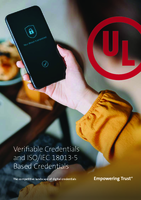
Verifiable Credentials and ISO/IEC 18013-5 Based Credentials
Navigate your business in an increasingly complex world with industry-leading research and actionable insights from UL Solutions.
Explore our press releases and news updates. Delve into detailed press kits for information on our work. If it’s UL Solutions and newsworthy, it’s here.
Connect with us in person or online, around the globe. We’re everywhere your business needs us to be.
As a global safety science leader, UL Solutions helps companies to demonstrate safety, enhance sustainability, strengthen security, deliver quality, manage risk and achieve regulatory compliance.
See how we put safety science to work to help create a safer, more secure and sustainable world for you.
Explore our business intelligence-building digital tools and databases, search for help, review our business information, or share your concerns and questions.
Accelerate your planning process and learn the requirements needed to take your products to market worldwide.
A secure, online source for increased visibility into your UL Solutions project files, product information, documents, samples and services.
Access UL certification data on products, components and systems, identify alternatives and view guide information with Product iQ.

ULTRUS™ helps companies work smarter and win more with powerful software to manage regulatory, supply chain and sustainability challenges.
A technical deep dive into digital credentials.

This UL white paper provides in-depth insight on two types of digital credentials, those that comply with the ISO/IEC 18013-5 standard for mobile driving licenses and those known as Verifiable Credentials (VCs), which comply with the Verifiable Credential Data Model specification published by the World Wide Web Consortium (W3C).
The origins and goals of the VC Data Model and ISO/IEC 18013-5 are covered. The white paper explains that although ISO/IEC 18013-5 was primarily developed for the mobile driving license, it is set up in such a way that it can be used for any other type of credential as well. The only change necessary is the definition of a data model. A detailed overview is given of the differences between the two, including
The whitepaper also discusses a number of ways in which a Verifiable Credential can be combined with ISO/IEC 18013-5, for example by storing it as a data element in an ISO/IEC 18013-5 based document.

Verifiable Credentials and ISO/IEC 18013-5 Based Credentials